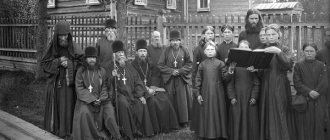The same sacraments operate in the Orthodox and Catholic Churches, but the rituals for their implementation are somewhat different. In both churches there are seven sacraments - baptism, confirmation (confirmation), repentance (confession), communion (Eucharist), marriage, priesthood, and consecration of oil. Differences in the performance of rituals are mainly due to historically established forms of implementation of the sacraments and church legal regulations.
Question and answer What divided Christians into Catholics and Orthodox?
Baptism
The difference between this sacrament is that Catholics perform the rite by pouring water on the head of the person being baptized three times, while in the Orthodox Church the rite is performed by immersing it in water three times. Both churches instruct believers to baptize children soon after birth. And adults who wish to be baptized must prepare for this sacrament and undergo catechesis. Translated from Greek, catechesis literally means “oral teaching.” That is, before being baptized, a person studies the basics of the Christian faith, the sacraments and dogmas of the church. This approach promotes conscious involvement in the church and its sacraments.
“Every Christian should imagine the Orthodox and Catholic faith. Another question is that in both Orthodoxy and the Catholic Church the process of catechesis depends on local conditions, but, in principle, catechesis itself is carried out by both Catholics and Orthodox,” says the priest, dean of the Faculty of History of St. Tikhon’s Humanitarian University Andrey Posternak.
Is it necessary to baptize a child on the 40th day after birth? More details
The most significant similarities between Orthodoxy and Catholicism
| Orthodoxy | Catholicism |
| The foundation of all life is the Lord Jesus Christ. | |
| Believers strive to live according to the commandments of Christ. | |
| They profess faith in the Holy Trinity, God, one in Three Persons - Father, Son and Holy Spirit. | |
| They have apostolic succession. | |
| They have seven church sacraments. | |
| Recognize the authority of Holy Scripture and Holy Tradition. | |
| They share a common spiritual Tradition of the first millennium of Christianity. | |
| They venerate Mary, the Mother of our Lord Jesus Christ, as the Ever-Virgin and Mother of God. | |
| They have a number of common saints who lived before the Great Schism of 1054. | |
| They have a general idea of the family. | |
| They call on everyone to respect the inalienable right to life, and do not accept abortion, euthanasia and other methods of killing a person. | |
| Homosexual marriages are not recognized. | |
| They preach the Gospel of Christ in the modern world. | |
Confirmation or Confirmation
In the Orthodox Church, confirmation is performed immediately after baptism (including infants), while in the Catholic Church confirmation is postponed until the age when the person accepts the faith quite consciously. The right to perform confirmation belongs only to bishops and priests.
“Catholics have two separate sacraments - the sacrament of baptism and the sacrament of confirmation. In the Orthodox Church they are performed simultaneously. If an infant or an adult is baptized, both sacraments are performed at once. And among Catholics, if an infant is baptized, then he is not immediately anointed. This sacrament occurs upon reaching conscious age, approximately 13-14 years old, and is called confirmation. This is a special sacrament, with confirmation. During confirmation, the Holy Mysteries of Christ are received for the first time. Infants are not given communion in the Catholic Church. In Orthodoxy this is not accepted, since confirmation is performed immediately, the child can be given communion immediately. If a child grows up in a church family, then he is therefore not deprived of church mysteries,” says the priest.
Catholic Confirmation. Photo: Shutterstock.com
Features of icon painting
Significant differences between Orthodoxy, Catholicism, and Protestantism are observed in icons. Jesus Christ, the Mother of God, and the Saints are depicted with differences. For Catholics, the hands on all icons are presented in such a way that the right one is always on top of the left. The Saints' eyes are always half-closed. The manufacturing process is quite ordinary; even ordinary artists are involved in it.
For Catholics, icons serve as simple decoration for churches and do not carry any semantic or religious value.
Fig 4 Protestants do not use icons at all, considering them an attribute of paganism. In Orthodoxy, iconostases are a special symbol and are equated to shrines.
Important! Orthodox icons are made in strict accordance with the ancient Byzantine canons and are always painted only by priests or monks. They are consecrated in the church and belong to special religious shrines.
Each icon has its own holiday and patron saint. There are prayers for each image in the prayer book.
Conducting religious services
There are also differences in the conduct of services in both churches. According to Posternak, in the Catholic Church, almost all the time, only one Mass is celebrated - an analogue of our Divine Liturgy. Mass can be celebrated several times at any time of the day in the same church, but this is not accepted in the Orthodox tradition.
“Liturgy can be celebrated in one church only in one altar and only once a day. It usually takes place in the morning, because everyone takes communion on an empty stomach. In addition to liturgies, a large number of services are performed in the Orthodox Church - these are evening services, all-night vigils and morning services. Catholics do not have this; they sometimes pray a prayer dedicated to the Mother of God, which is called the “Rosary”. But Catholics do not have all-night vigils, morning or evening services. There are also no prayers, akathists; Catholics perform them extremely rarely, on some special occasions. In addition, Catholics translated all liturgical texts into national languages. The traditional Latin language, in which Catholic services were performed in the Middle Ages, is practically no longer used in worship. In every church in a Catholic country you can hear a service in your native language. In the Orthodox church, services are still performed in Church Slavonic,” says Posternak.
During services, Catholics tend to kneel, while Orthodox parishioners usually stand.
“Children are in the temple if the parents are there.” How do Catholics educate their parishioners? More details
How did Christians appear?
What is the good news, why did it spread so quickly after the gospel events and how did it take root in ancient soil?
Pavel Kuzenkov
What is the good news, why did it spread so quickly after the gospel events and how did it take root in ancient soil?
36 minutes
2/9
Repentance or Confession
During this sacrament, the believer confesses his sins to God in the presence of a priest and through him receives forgiveness from Jesus Christ. To receive forgiveness of sins from the confessor, reconciliation with all his neighbors, sincere awareness of his sins and their true confession are required. Confession among Catholics and Orthodox Christians is carried out in different forms. In an Orthodox church a special place is reserved for performing this sacrament. During confession, the believer, in the presence of a priest, before the Cross and the Gospel, confesses his sins to God, after which the priest makes a special, permissive prayer over the bowed head of the penitent. In a Catholic church, priests retire with penitents to special booths with lattice partitions - confessionals or confessionals, which are located in a remote part of the church.
The need for performing this sacrament also differs. Orthodox Christians must confess before the liturgy and communion. “Before the liturgy, it is imperative to confess. At the very least, a person should do this shortly before communion. Catholics do not separate confession and communion, and therefore they do not have such a mandatory requirement as confessing before communion,” says the priest.
In what cases can the secret of confession be violated? More details
Mutual influence of Orthodoxy and Catholicism
| The influence of Orthodoxy on Catholicism | |
| 1 | When they were created, the Greek Catholic communities started from the Byzantine liturgical tradition. |
| 2 | The Eastern tradition was a notable influence in the reform of the Roman Mass after the Second Vatican Council. |
| 3 | In Catholicism, interest in the Orthodox icon is steadily growing, examples of which can be seen today in many Latin churches. |
| 4 | The attention of Catholics nowadays is often drawn to the works of Orthodox theologians. |
| 5 | Recognition of the authority of saints glorified by the Orthodox Church after the Great Schism, for example: John of Kronstadt, Sergius of Radonezh, Seraphim of Sarov, but without glorification in the Catholic Church |
| The influence of Catholicism on Orthodoxy | |
| 1 | The concept of the seven sacraments is initially found in Peter of Lombardy (12th century) and Thomas Aquinas (13th century) in the Catholic West. |
| 2 | Scholasticism has long been a characteristic feature of Russian theological thought, since St. Peter (Mogila), who founded the Kyiv Theological Academy, and his colleagues were educated in Catholic schools. |
| 3 | Orthodox iconography was influenced by Catholic iconography for some time. This applies both to the formation of the “Fryazhsky style” and to the almost complete transition of Russian icon painting in the 18th-19th centuries to an academic style. |
| 6 | The Catholic tradition had an influence on Orthodox church architecture during the Russian Empire. |
| 7 | Under Catholic influence, some services arose, for example, the passion. |
Sacrament of marriage
The sacrament of marriage is performed in the presence of a priest, the bride and groom who have expressed a desire to live together. The Roman Catholic Church is distinguished from the Orthodox Church by its complete exclusion of divorce.
“In the Catholic Church, marriage is considered indissoluble, they do not have the practice of a second wedding, and there is no church divorce among Catholics. The Orthodox Church does not recognize divorce as such either, but there is a special order for newlyweds under special conditions, which are negotiated in each case with the bishop and the priest. A second wedding ceremony may be allowed for people who are getting married for the second time. Catholics don’t have this,” explains the priest.
How many times can you get married? More details
Monasticism
In each of the Christian directions, differences also apply to monasticism. In most countries, the monastery is an autonomous organization and has its own full-fledged leadership, the main one of which is the bishop. Representatives of the Catholic Church have monasteries created on the basis of Orders, with a separate charter and chapter. Such church unions may be scattered throughout the world, but will be subject to one leadership. Monasteries can be considered an even more separate and independent part of the church than the church itself.
Fig 5 One of the leading types of monasticism in Catholicism includes spiritual-knightly associations - the Templars, Hospitallers, etc. The patron and spiritual father of Orthodox monasticism is St. Basil.
Protestants do not accept the presence of monasteries in their teaching. One of the founders of this movement, Luther, even married a nun. For several centuries now, followers of this religion have been purposefully ignoring monasticism.
Priesthood
In this sacrament, a Christian who has been ordained as a deacon, priest or bishop is elevated to the appropriate degree of priesthood for special church service. Only a bishop can perform the sacrament of priesthood. The consecration of a bishop is usually carried out by several bishops. Catholics today recognize the principle of celibacy of the clergy, the so-called celibacy, elevated by Pope Gregory VII . Only deacons can be non-celibate.
“There are certain differences in the sacrament of the priesthood, namely, the rites. Orthodoxy recognizes the ordination of Catholics. If a Catholic priest decides to convert to Orthodoxy, then no one will specifically ordain him, as well as vice versa. Thus, the sacrament of the priesthood is mutually recognized by both Catholics and Orthodox under certain conditions. If we talk about Orthodox priests, then they cannot participate in Catholic sacraments. We do not have Eucharistic communion and therefore priests cannot receive communion or confession, nor can they be baptized in Catholic churches. Catholics have more lenient conditions in this regard; for example, they are ready to accept Orthodox sacraments. Another question is that on our side such mutual communication does not exist,” says Posternak.
How is the Patriarch different from the Pope? More details
Christian cross: differences
Differences between churches also affect basic religious attributes. In Catholicism, the cross is characterized by a simple quadrangular shape. For Orthodox believers it is eight-pointed. Representatives of the Eastern Church claim that this form most fully corresponds to the New Testament. The upper additional crossbar symbolizes the tablet nailed to the cross with the inscription “Jesus of Nazareth, King of the Jews.” The lowest, oblique one serves as a support for Jesus’ feet and represents the “standard of righteousness.”
On crosses of different directions the savior is also depicted with differences. The image of the living Jesus Christ, who defeated death on the four-pointed cross, is very realistic. Sometimes such icons are created with streams of blood, the legs are connected together and nailed. On the head of the Son of God is a crown of thorns, as a symbol of special torment and suffering. All visual differences can be seen in the picture with crosses. In the Protestant Church, the cross serves as a symbol of the Pope, so it is used very rarely.
Fig. 3 The crucifixion of Jesus on the cross among the Orthodox is not shown as naturally and realistically as among Catholics.
Blessing of Anointing (Unction)
Unction is performed by one or more priests and consists of prayers and anointing of the forehead and palms of the unction with consecrated oil. There are no special differences regarding this sacrament. However, in Orthodox churches this ritual is performed not only with the dying, but also with people whose health has deteriorated.
“As for the consecration of oil, or unction, the Catholic Church still maintains a tradition associated with the sacrament that is performed before death. That is, unction is performed on elderly people who are on the threshold of earthly life. In the Orthodox tradition there is no such judgment; any adult can participate in unction, but not an infant. In our tradition, unction takes place during Great Lent and Peter’s Lent,” says Posternak.
How to prepare for the Unction? More details
How Russia became the main Orthodox country
How did the Russian Empire go towards the emergence of its own theological tradition and when did the golden age of Russian religious thought begin?
Archpriest Georgy Mitrofanov
How did the Russian Empire go towards the emergence of its own theological tradition and when did the golden age of Russian religious thought begin?
36 minutes
7/9
Conclusion
To summarize, I would like to say that today we are talking about the future of Christian civilization, if you like - about its survival. And I think that in this situation it would be very correct and timely to unite the efforts of those Christians who stand on traditional moral positions, and these are, first of all, Orthodox and Catholics. If we can join forces, we can do much more for the welfare and well-being of people. I think that in our dialogue with Catholics this is a task of primary importance. For the sake of its implementation, you can abandon offensive terminology, you can sit at the negotiating table, you can make various efforts on both sides - after all, we are talking about real life and the real welfare of people.
As for the theological dialogue, it will develop in its own way. Maybe someday it will lead to some results, maybe not. We don't know this now. But we must, without waiting for these results, build our relationships with Catholics here and now - build them on the basis of mutual respect and the desire to interact in everything in which we can interact today, without compromising our principles.









